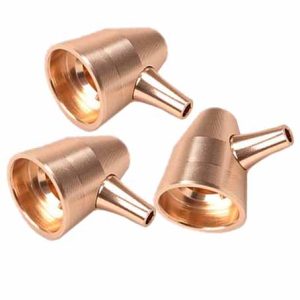Product Categories
Product Tags
Precision turning of earphone metal fittings
Machining of copper and aluminum parts of earphones
1. The processing route of earphone metal fittings has great uncertainty. A component or product can have multiple processes, and the production process requires a wide variety of machinery and equipment and fixtures.
Category: CNC turning services
Tag: CNC turning
Machining of copper and aluminum parts of earphones
1. The processing route of earphone metal fittings has great uncertainty. A component or product can have multiple processes, and the production process requires a wide variety of machinery and equipment and fixtures.
2. Hardware manufacturing enterprises are mainly scattered processing. The quality and production rate of headset products depend to a large extent on the technical level of workers, while the degree of automation is mainly at the unit level, such as CNC machine tools, flexible production systems, and so on.
3. Headphone parts and components generally adopt the method of combining self-made and outsourcing processing. For example, special processes such as electroplating, sandblasting, oxidation, silk screen laser engraving, etc. will be entrusted to external manufacturers for processing.
4. For the required earphone parts, there are often many picking lists and the “one-line” production list will be seen on the workshop site. If there is a process to handle, a lot of process transfer forms need to be filled in.

Machining of earphone accessories
Contact Us
Waiting for your email, we will reply you within 12 hours with valuable information you needed.
RELATED PRODUCTS
Custom Copper Precision Turning Parts
Our company is good at turning all kinds of copper parts, all kinds of valve parts, electrical bronze parts, brass nuts, mobile phone antennas, external knurling (straight grain / twill / net grain) and so on. The picture on the left shows a turned copper core. Used in valves, the material is C3604 fast-cutting steel brass, and the copper turning parts customized according to customer requirements are used as the valve stem and valve core. Used in valves of internationally renowned brands. Automatic turning and forming, after the head milling edge and the rod milling edge, the angle is 60 degrees. Slotted head. The outer diameter is 12.7mm, and the total length is 70mm. The forming turning tool has been used many times in the processing of this copper precision part. In order to solve the accuracy of the R angle and chamfering of the inner groove, CNC machining was initially adopted. Later, in order to save costs, automatic lathe processing was used.
Customized Machining Titanium Flange
Titanium flange is a part made of titanium or titanium alloy, also called flange flange or flange. Flange is a part that connects between shaft and shaft and is used for connection between pipe ends. It is also useful for flanges on the inlet and outlet of equipment for the connection between two equipment, such as reducer flanges. Flange connection or flange joint refers to a detachable connection in which flanges, gaskets and bolts are connected to each other as a set of combined sealing structures.
OEM 304 Stainless Turning Precision Component
Our company produces SUS303, 304, SUS400 series, 316F stainless steel precision turning parts and lathe parts of various specifications and sizes.
The product on the left is a representative stainless steel turning part produced by our company:
Stainless steel turning parts with threads, steps and milled hexagonal edges are made of SUS303 stainless steel, thread specification M4,
Maximum outer diameter (ie its head diameter): 10mm, total length 38mm
Features: Axial face milling hexagonal, large turning volume, high precision, semi-finished products are completed by automatic lathe + hydraulic milling machine milling hexagonal face + thread rolling machine rolling. This turning part is used in a well-known electrical appliance for fastening and adjustment.
Precision turning process of large threaded shaft
Ordinary lathes sometimes experience bed saddle vibration when turning large-pitch threads forcefully. Lighter ones will cause ripples on the machined surface, and severer ones will break the knife. When cutting off, there are often knife sticking or broken tools. There are many reasons for the above problems. This phenomenon and its solution are mainly discussed through the analysis of the force of the turning tool.
The difference between automatic lathe and CNC lathe machining
Different metal nuts processed by automatic lathe
Our company provides automatic lathe processing of various nuts, including but not limited to the insert nuts for injection molding as shown in the left picture. There are a large number of examples of this product in other directories on this website:
It also includes hexagonal and thin copper nuts, non-standard special nuts, etc. The process of turning various nut parts on automatic lathes.
 English
English العربية
العربية 中文(漢字)
中文(漢字) Čeština
Čeština Dansk
Dansk Nederlands
Nederlands Suomi
Suomi Français
Français Deutsch
Deutsch Italiano
Italiano 日本語
日本語 ಕನ್ನಡ
ಕನ್ನಡ 한국어
한국어 Português
Português Русский
Русский Slovenčina
Slovenčina Español
Español Svenska
Svenska Türkçe
Türkçe




